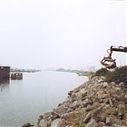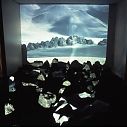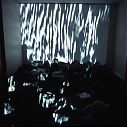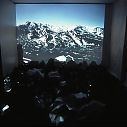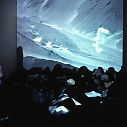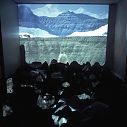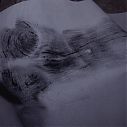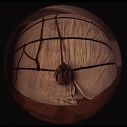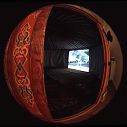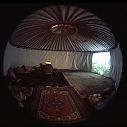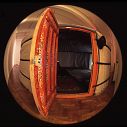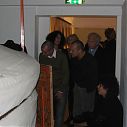Lekart
Himalayanwalk video-installation Ι
The stones needed for the video-installation Himalayanwalk at Lek Art festival in Culemborg were courteously lent out by the Dutch State Water Department.
Ten tons of stones were uploaded from the pile of emergency supplies and transported by Royal Road Construction Works Volker Stevin (KWS), from the Noordersluis at IJmuiden to Culemborg near Utrecht. At the site in Culemborg, the Helias House, the stones were deposited and then carried in by hand and wheelbarrow by the artist herself.
The floor-surface of 25 square meters in front of the projection wall was almost completely covered by the stones. But due to protests of the building owner, the municipal council of Culemborg decided that no more large stones were permitted to be carried inside. Thus, the left-over stones had to be aligned along the building with the help of a municipal owned shovel. The historical building in the center of town was uninhabited and unfortunately on the verge of being torn down, unless a project developer would buy it for renovation.
Consequently, the video-images of Himalayanwalk were then partially projected on the stones, creating a line of rugged shadows on the base of the wall. In the dark space, only lit by the video-images, and surrounded by the howling sound of the wind, the viewer finds him/herself encompassed by the virtual elements.
Two leather aprons with a body-print were placed on the stones. They refer to the ritual of prostrating performed by Buddhist pilgrims in the Himalayas, in order to gain positive merit.
click on the image to enlarge
InTransit
Himalayanwalk video-installation ΙΙ
The video Himalayanwalk was shown in this Mongolian Gher during the exhibition InTransit at Arti et Amicitiae in Amsterdam. The tent was rent from a company called “neverinahurry” (www.nooitmeerhaast.nl). The traditional khamseh and qashqai carpets from the region of Shiraaz were courteously provided by Iranian carpet-dealer Saïd.
Viewers could sit down on the pillows and absorb the intimacy and seclusion of the tent while being virtually exposed to the audible and visual elements.
